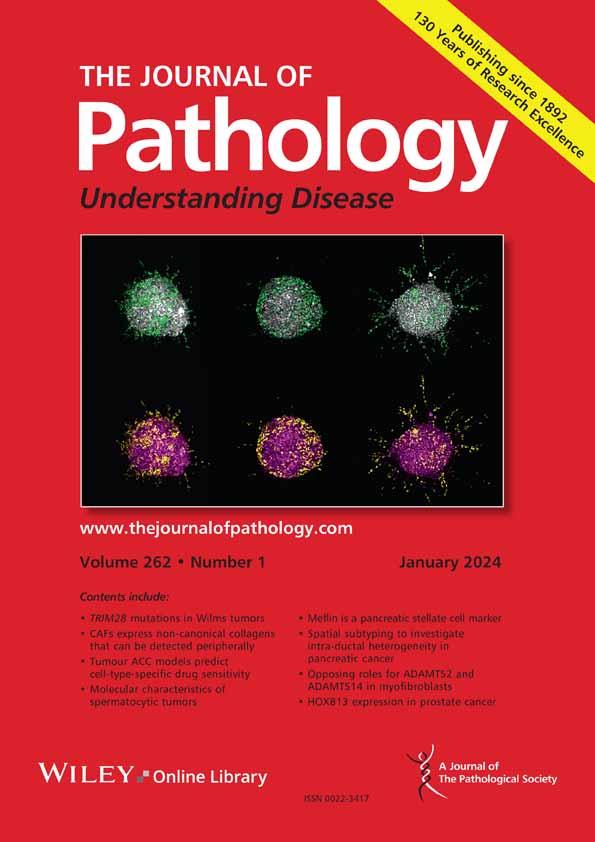下载PDF
{"title":"结直肠癌中BMP信号传导:WNTs阳失阴。","authors":"Eloise Clarkson, Annabelle Lewis","doi":"10.1002/path.6428","DOIUrl":null,"url":null,"abstract":"<p>Colorectal cancer (CRC) is the third most common form of cancer globally, and arises from the hyperproliferation of epithelial cells in the intestine. The architecture and maintenance of these cells is governed by two major signalling pathways working in a counter-gradient: the stem cell WNT signalling pathway, and the prodifferentiation bone morphogenetic protein (BMP) pathway. It has long been known that this WNT-BMP balance is disrupted in CRC, with hyperactive WNT signalling leading to increased proliferation of epithelial cells and tumour progression. BMP signalling, and its prodifferentiation effects, have increasingly become a focus for CRC research. Loss of BMP signalling, and that of its receptors, has been shown to increase WNT signalling and cancer stem cells in CRC. BMP signalling is further modulated through secreted BMP antagonists localised to the intestinal crypts, which create a niche ensuring that sustained WNT signalling can maintain stem-cell self-renewal capacity. A number of studies combine to demonstrate the effects of overexpression of these BMP antagonists, showing that hyperactivity of the stem-cell-supporting WNT signalling pathway ensues, leading to deregulation of the intestinal epithelium. Cellular hyperproliferation, the emergence of ectopic crypts, and an increase in stem cell numbers and characteristics are common themes, contributing to disrupted epithelial homeostasis, an increase in CRC risk and progression, and resistance to therapy. This review aims to compile the current knowledge on BMP antagonists, their role in CRC development, and how we can utilise this information for biomarker research and novel therapeutics. © 2025 The Author(s). <i>The Journal of Pathology</i> published by John Wiley & Sons Ltd on behalf of The Pathological Society of Great Britain and Ireland.</p>","PeriodicalId":232,"journal":{"name":"The Journal of Pathology","volume":"266 3","pages":"280-291"},"PeriodicalIF":5.2000,"publicationDate":"2025-04-11","publicationTypes":"Journal Article","fieldsOfStudy":null,"isOpenAccess":false,"openAccessPdf":"https://onlinelibrary.wiley.com/doi/epdf/10.1002/path.6428","citationCount":"0","resultStr":"{\"title\":\"BMP signalling in colorectal cancer: losing the yin to WNTs yang\",\"authors\":\"Eloise Clarkson, Annabelle Lewis\",\"doi\":\"10.1002/path.6428\",\"DOIUrl\":null,\"url\":null,\"abstract\":\"<p>Colorectal cancer (CRC) is the third most common form of cancer globally, and arises from the hyperproliferation of epithelial cells in the intestine. The architecture and maintenance of these cells is governed by two major signalling pathways working in a counter-gradient: the stem cell WNT signalling pathway, and the prodifferentiation bone morphogenetic protein (BMP) pathway. It has long been known that this WNT-BMP balance is disrupted in CRC, with hyperactive WNT signalling leading to increased proliferation of epithelial cells and tumour progression. BMP signalling, and its prodifferentiation effects, have increasingly become a focus for CRC research. Loss of BMP signalling, and that of its receptors, has been shown to increase WNT signalling and cancer stem cells in CRC. BMP signalling is further modulated through secreted BMP antagonists localised to the intestinal crypts, which create a niche ensuring that sustained WNT signalling can maintain stem-cell self-renewal capacity. A number of studies combine to demonstrate the effects of overexpression of these BMP antagonists, showing that hyperactivity of the stem-cell-supporting WNT signalling pathway ensues, leading to deregulation of the intestinal epithelium. Cellular hyperproliferation, the emergence of ectopic crypts, and an increase in stem cell numbers and characteristics are common themes, contributing to disrupted epithelial homeostasis, an increase in CRC risk and progression, and resistance to therapy. This review aims to compile the current knowledge on BMP antagonists, their role in CRC development, and how we can utilise this information for biomarker research and novel therapeutics. © 2025 The Author(s). <i>The Journal of Pathology</i> published by John Wiley & Sons Ltd on behalf of The Pathological Society of Great Britain and Ireland.</p>\",\"PeriodicalId\":232,\"journal\":{\"name\":\"The Journal of Pathology\",\"volume\":\"266 3\",\"pages\":\"280-291\"},\"PeriodicalIF\":5.2000,\"publicationDate\":\"2025-04-11\",\"publicationTypes\":\"Journal Article\",\"fieldsOfStudy\":null,\"isOpenAccess\":false,\"openAccessPdf\":\"https://onlinelibrary.wiley.com/doi/epdf/10.1002/path.6428\",\"citationCount\":\"0\",\"resultStr\":null,\"platform\":\"Semanticscholar\",\"paperid\":null,\"PeriodicalName\":\"The Journal of Pathology\",\"FirstCategoryId\":\"3\",\"ListUrlMain\":\"https://pathsocjournals.onlinelibrary.wiley.com/doi/10.1002/path.6428\",\"RegionNum\":2,\"RegionCategory\":\"医学\",\"ArticlePicture\":[],\"TitleCN\":null,\"AbstractTextCN\":null,\"PMCID\":null,\"EPubDate\":\"\",\"PubModel\":\"\",\"JCR\":\"Q1\",\"JCRName\":\"ONCOLOGY\",\"Score\":null,\"Total\":0}","platform":"Semanticscholar","paperid":null,"PeriodicalName":"The Journal of Pathology","FirstCategoryId":"3","ListUrlMain":"https://pathsocjournals.onlinelibrary.wiley.com/doi/10.1002/path.6428","RegionNum":2,"RegionCategory":"医学","ArticlePicture":[],"TitleCN":null,"AbstractTextCN":null,"PMCID":null,"EPubDate":"","PubModel":"","JCR":"Q1","JCRName":"ONCOLOGY","Score":null,"Total":0}
引用次数: 0
引用
批量引用





 求助内容:
求助内容: 应助结果提醒方式:
应助结果提醒方式:


